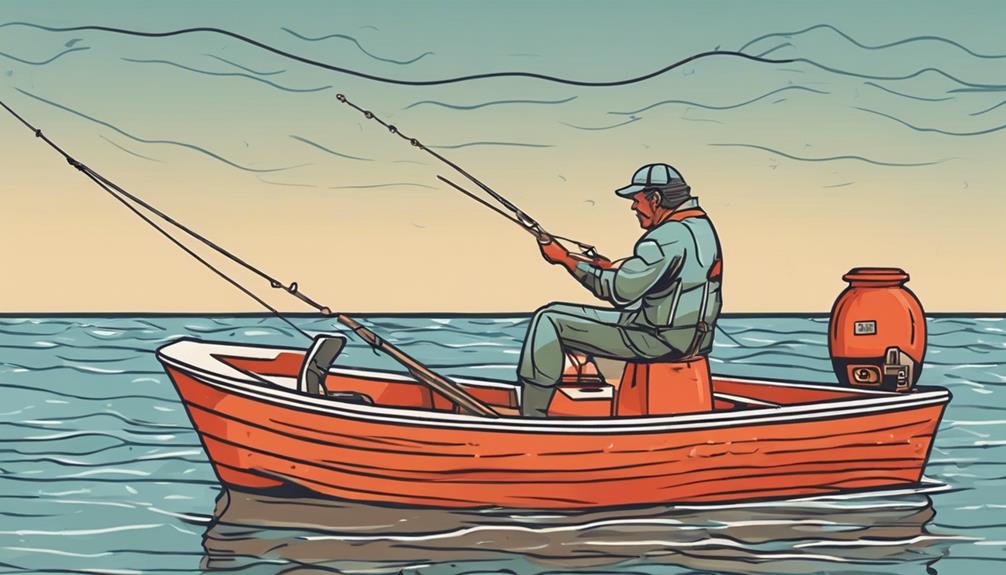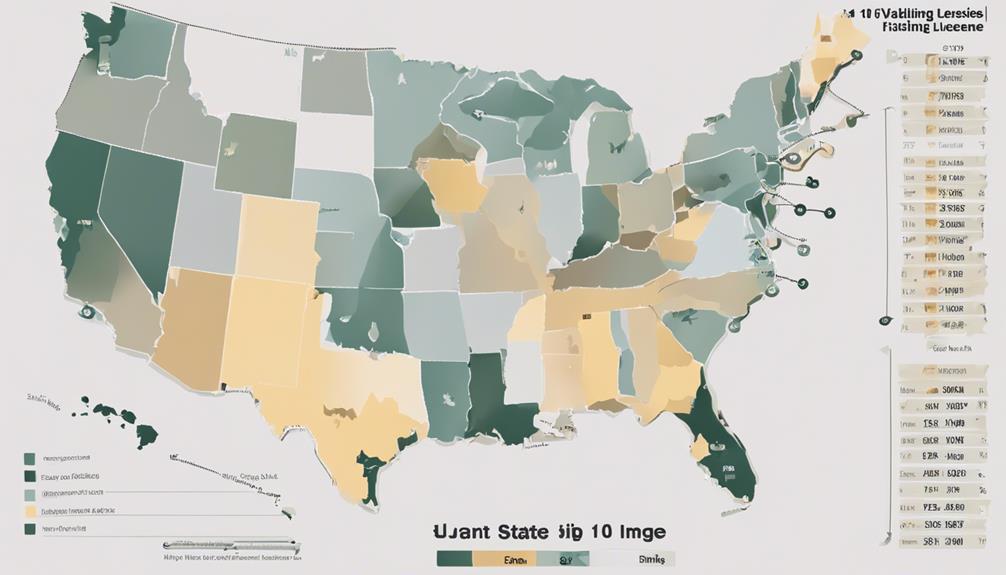If you're planning a redfish fishing trip in Texas, here's an eye-opener: Did you know that the current minimum size limit for redfish in Texas is 20 inches?
Understanding the regulations governing redfish fishing in Texas is crucial to ensure sustainable fishing practices and conservation of this prized species.
From size and bag limits to special tag requirements and seasonal restrictions, navigating the waters of redfish fishing regulations can be complex but essential for responsible anglers.
Stay informed about the 10 key regulations to make the most of your redfish fishing experience in Texas.
Redfish Size Limits
When fishing for redfish in Texas, ensure you adhere to the specified size limits to protect the population. Redfish size limits are crucial for maintaining healthy population dynamics and sustaining growth rates. Redfish, also known as red drum, are a popular sport fish in Texas coastal waters, but their populations need careful management to prevent overfishing and ensure their long-term sustainability.
By regulating the size limits of redfish that can be harvested, authorities aim to safeguard the reproductive potential of the population. Redfish have different growth rates depending on factors like food availability and habitat quality. Allowing redfish to reach a certain size before they can be legally harvested gives them the opportunity to reach maturity and contribute to the replenishment of the population.
Understanding the growth rates of redfish is essential for setting appropriate size limits. Young redfish grow rapidly, but growth slows as they reach maturity. By targeting larger redfish for harvest, anglers can help maintain a balanced age structure within the population. This, in turn, supports healthy population dynamics by ensuring there are enough mature individuals to reproduce and sustain the population in the long run.
Bag and Possession Limits
To ensure sustainable redfish populations, adhere to the bag and possession limits set by Texas authorities. Redfish conservation is crucial for maintaining healthy populations in Texas waters. By following the bag and possession limits, you contribute to the monitoring efforts aimed at ensuring the sustainability of redfish populations.
In Texas, the bag limit for redfish is three fish per angler per day, with a minimum size limit of 20 inches and a maximum size limit of 28 inches. Possession limits are twice the daily bag limits, meaning anglers can have up to six redfish in their possession, given they comply with the size restrictions. These regulations are in place to prevent overfishing and help maintain a healthy redfish population in Texas coastal waters.
Special Redfish Tag Requirements
Consider obtaining a special redfish tag if you plan to target redfish beyond the daily bag and possession limits in Texas. Redfish tag requirements are put in place as part of conservation efforts to ensure the sustainability of the redfish population in Texas waters. These tags are crucial for monitoring and managing the harvest of redfish, which helps in maintaining a healthy ecosystem for this popular game fish.
To legally possess redfish exceeding the daily bag limit, anglers must possess a special redfish tag. This tag is obtainable from the Texas Parks and Wildlife Department (TPWD) and is a vital component of responsible fishing practices. By adhering to these redfish tag requirements, you contribute to the conservation efforts aimed at preserving redfish populations for future generations of anglers.
Failure to comply with redfish tag requirements can result in significant fines and penalties. Therefore, it's essential to familiarize yourself with the regulations and ensure you have the necessary tags before targeting redfish beyond the specified limits. Conservation efforts rely on the cooperation of all anglers to protect the redfish population and maintain a sustainable fishery in Texas. By obtaining and using redfish tags correctly, you play a crucial role in supporting these efforts and safeguarding the redfish population for the enjoyment of all.
Catch and Release Guidelines
If you're releasing redfish back into the water, ensure you follow the proper catch and release guidelines to promote their survival and well-being. Redfish conservation is vital for maintaining healthy populations in Texas waters. When practicing catch and release, it's essential to handle the fish with care to increase its chances of survival.
Here are some ethical angling practices to consider:
Firstly, use barbless hooks to minimize injury to the fish. Barbless hooks are easier to remove, reducing handling time and trauma. Secondly, avoid using stainless steel or deeply set hooks that can cause internal damage. Opt for circle hooks, which are known to hook the fish in the mouth, decreasing the risk of gut-hooking.
Additionally, minimize air exposure. Redfish are sensitive to changes in pressure and can suffer from barotrauma if brought up too quickly. Keep the fish in the water as much as possible, especially when removing the hook. If you need to handle the fish, make sure your hands are wet to protect its slime layer, which is crucial for its health.
Restricted Areas for Redfish Fishing
When fishing for redfish in Texas, be aware of designated restricted areas to ensure compliance with local regulations. Conservation efforts and fishing impact are crucial considerations when it comes to these restricted areas. Texas has implemented these restrictions to protect the redfish population and their habitats.
Environmental protection and habitat preservation are at the forefront of these regulations. Certain areas are off-limits to fishing to prevent overfishing and to allow redfish populations to thrive. By respecting these restricted areas, you're contributing to the sustainability of redfish populations and the overall health of the marine ecosystem.
Restricted areas are often marked with buoys or signs indicating no-fishing zones. It's essential to familiarize yourself with these designated areas before heading out to fish for redfish. Ignoring these restrictions can have detrimental effects on redfish populations and their habitats.
When fishing in Texas, always check local regulations and maps to identify any restricted areas. By abiding by these rules, you're playing a vital role in the conservation of redfish and their environment. Remember, protecting these restricted areas ensures that future generations can also enjoy the thrill of redfish fishing in Texas.
Seasonal Redfish Fishing Restrictions
Make sure to always check the current seasonal redfish fishing restrictions before heading out on your fishing trip in Texas. Understanding these regulations is crucial for protecting the redfish population and ensuring the sustainability of this prized species. Here are some key points to consider:
- Redfish Spawning: Seasonal restrictions are often in place to protect redfish during their spawning season. By avoiding fishing in these crucial times, you can help support the conservation efforts aimed at maintaining healthy redfish populations.
- Conservation Measures: These restrictions are put in place to conserve redfish stocks for future generations. Respecting the seasonal fishing limits is essential to prevent overfishing and promote the long-term sustainability of redfish in Texas waters.
- Population Management: Monitoring seasonal redfish fishing restrictions is vital for effective population management. By adhering to these regulations, you contribute to the overall health of the redfish population and ecosystem.
- Sustainability Practices: Engaging in responsible fishing practices, including following seasonal restrictions, is key to promoting the sustainability of redfish. Your actions can make a difference in preserving this iconic species for years to come.
Redfish Gear and Bait Regulations

Ensure compliance with redfish gear and bait regulations in Texas to support sustainable fishing practices and protect the redfish population.
When gearing up for redfish fishing, consider the tackle options and bait choices permitted in Texas waters. Common tackle options include spinning reels paired with medium to heavy action rods, suitable for handling the strength of redfish. Braided lines in the 20-30 lb range are popular due to their durability and sensitivity, aiding in detecting subtle redfish bites. For bait, live options like shrimp, mullet, or crab are effective in attracting redfish. Artificial lures such as spoons, soft plastics, and topwater plugs can also be successful, mimicking the movement of natural prey.
When it comes to fishing techniques and equipment preferences, practicing catch-and-release can help conserve the redfish population. Using circle hooks instead of J-hooks can minimize harm to the fish, increasing their chances of survival when they're released. Additionally, having a dehooking tool on hand allows for quick and safe hook removal, reducing stress on the fish. Consider using a landing net to handle redfish gently, especially larger specimens, to avoid causing unnecessary harm or exhaustion.
Enforcement of Redfish Regulations
To enforce redfish regulations effectively, familiarize yourself with the specific rules and restrictions set forth by the Texas Parks and Wildlife Department. Understanding the regulations is crucial in ensuring the protection and sustainability of the redfish population in Texas waters.
Enforcement Challenges:
- Limited Resources: Wildlife enforcement officers often face challenges due to limited resources, making it difficult to patrol vast waterways effectively.
- Illegal Poaching Hotspots: Identifying and monitoring areas where illegal poaching activities are prevalent poses a significant challenge for enforcement agencies.
- Nighttime Poaching: Poachers often take advantage of the cover of darkness to engage in illegal activities, complicating enforcement efforts.
- Lack of Public Awareness: Inadequate knowledge among the public about redfish regulations can lead to unintentional violations, adding complexity to enforcement measures.
Frequently Asked Questions
Can I Use Artificial Lures When Fishing for Redfish in Texas?
When fishing for redfish in Texas, you can definitely use artificial lures. They're often just as effective as traditional bait and can even outperform them in certain situations.
Keep in mind the regulations regarding the use of artificial lures in the specific area you're fishing. Always check the rules to ensure you're in compliance with local regulations.
Are There Any Specific Areas Where Redfish Fishing Is Prohibited in Texas?
In Texas, some areas are designated as protected for redfish to help conserve their population. These zones aim to safeguard the fish during critical times, such as spawning or growth periods. It's crucial to respect these boundaries to ensure the sustainability of redfish populations.
Additionally, catch limits are in place to prevent overfishing and maintain healthy stock levels for future generations of anglers to enjoy. Be mindful of these regulations to contribute to the conservation efforts.
How Can I Differentiate Between a Redfish and Other Similar Species While Fishing?
When fishing, you can tell redfish apart from similar species by looking for distinct identifying features like a black spot on their tail.
Remember to also keep track of catch limits to ensure you stay within legal bounds.
Are There Any Specific Time Restrictions for Fishing for Redfish in Texas?
When fishing for redfish in Texas, it's important to know if there are specific time restrictions. Understanding the ideal fishing spots and utilizing the best baits and fishing techniques can significantly improve your chances of a successful catch.
Remember to check local regulations for any time restrictions that may apply to redfish fishing in Texas. By being aware of these details, you can plan your fishing trips more effectively and increase your chances of a rewarding experience.
What Are the Penalties for Violating Redfish Fishing Regulations in Texas?
If you're caught breaking redfish fishing rules in Texas, penalty consequences can be severe. Violating catch limits may lead to fines, license suspension, or even criminal charges.
It's important to follow regulations to protect redfish populations and avoid facing these penalties. Always check the rules before heading out to fish, and remember that ignorance of the law isn't an excuse.
Be responsible and respect the regulations to enjoy fishing sustainably.
Conclusion
So, remember to follow these key regulations for redfish fishing in Texas to ensure the sustainability of the redfish population and maintain a healthy ecosystem.
By adhering to:
- Size limits
- Bag and possession limits
- Special tag requirements
- Catch and release guidelines
- Restricted areas
- Seasonal restrictions
- Gear and bait regulations
- Cooperating with enforcement efforts
You can help protect this beloved species for future generations of anglers to enjoy.
Happy fishing!



